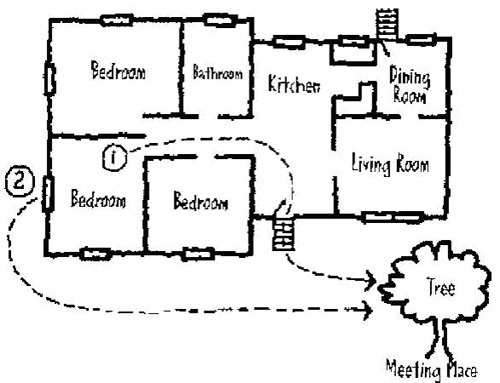Draw a floor plan of your home:
Use a grid to draw a floor plan of your home, including a drawing for each floor. Include all possible emergency exits. Draw in all walls, doors, windows and stairs. This will show you and your family all possible escape routes at a glance.
Identify all possible emergency exits and escape routes:
Draw in all doors, windows and stairs including any features such as access to garage or porch roofs which may provide a safe passage to ground and/or help with your escape.
Identify two escape routes from each room:
Since many fires occur during times when occupants are sleeping, special consideration must be given to planning escape routes from bedrooms.
The door to a room will be the main exit from each room. However, if the door is blocked by smoke or fire, identify alternate routes which may provide a safe exit such as a window. Alternate exits from a room must be practical and easy to use by occupants. Ensure windows are easily opened and everyone knows how to operate the window and safely exit through it. Windows equipped with security bars can be fitted with quick releasing devices. Safety equipment such as emergency escape ladders are also available (contact your local safety equipment supply store for more information).
People requiring assistance:
Very young children, elderly and occupants with disabilities may require assistance to safely escape from your home. A few minutes of planning will save valuable seconds in an emergency. Decide in advance who will assist people requiring assistance.
Outside meeting place:
A meeting place is necessary in order to account for all occupants and quickly identify anyone who may be missing. Choose a meeting place that everyone will remember. Your meeting place must be a safe distance from the house. A tree, light post, or a neighbour's house are all good choices. In the event of an emergency, all occupants should go directly to the meeting place. Once outside, stay outside. Never go back into a burning building under any circumstances.
Call the fire department from a neighbour's home:
Do not waste valuable time calling the fire department from within your home. Once at the meeting place, send someone to a neighbour's home (or by cell phone) to call the fire department by dialing 9-1-1.
Practice, Practice, Practice!
Review the entire plan with everyone in your household and ensure everyone (including children) understands it. Discuss primary and secondary escape routes. Walk through the escape routes for each room with the entire family to make sure all exits are practical and easy to use. It is important that all windows will open and that no heavy furniture blocks escape routes. If escape ladders are to be used, make sure they are accessible and the appropriate individual is capable of using them.
Conduct fire drills at least twice a year (once during winter and once during summer). Start your drill by activating the test function of your home's smoke alarm to initiate your family's response and carry out your "Home Escape Plan".
In a real fire, you must react without hesitation; your practice drills will ensure that everyone knows what to do if fire strikes.